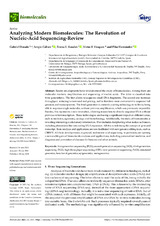Mostrar el registro sencillo del ítem
Analyzing Modern Biomolecules: The Revolution of Nucleic-Acid Sequencing-Review
| dc.contributor.author | Dorado, G. | |
| dc.contributor.author | Gálvez, Sergio | |
| dc.contributor.author | Rosales, Teresa E. | |
| dc.contributor.author | Vásquez, Víctor F. | |
| dc.contributor.author | Hernández, Pilar | |
| dc.date.accessioned | 2021-07-28T10:56:59Z | |
| dc.date.available | 2021-07-28T10:56:59Z | |
| dc.date.issued | 2021 | |
| dc.identifier.uri | http://hdl.handle.net/10396/21544 | |
| dc.description.abstract | Recent developments have revolutionized the study of biomolecules. Among them are molecular markers, amplification and sequencing of nucleic acids. The latter is classified into three generations. The first allows to sequence small DNA fragments. The second one increases throughput, reducing turnaround and pricing, and is therefore more convenient to sequence full genomes and transcriptomes. The third generation is currently pushing technology to its limits, being able to sequence single molecules, without previous amplification, which was previously impossible. Besides, this represents a new revolution, allowing researchers to directly sequence RNA without previous retrotranscription. These technologies are having a significant impact on different areas, such as medicine, agronomy, ecology and biotechnology. Additionally, the study of biomolecules is revealing interesting evolutionary information. That includes deciphering what makes us human, including phenomena like non-coding RNA expansion. All this is redefining the concept of gene and transcript. Basic analyses and applications are now facilitated with new genome editing tools, such as CRISPR. All these developments, in general, and nucleic-acid sequencing, in particular, are opening a new exciting era of biomolecule analyses and applications, including personalized medicine, and diagnosis and prevention of diseases for humans and other animals. | es_ES |
| dc.format.mimetype | application/pdf | es_ES |
| dc.language.iso | eng | es_ES |
| dc.publisher | MDPI | es_ES |
| dc.rights | https://creativecommons.org/licenses/by/4.0/ | es_ES |
| dc.source | Biomolecules 11(8), 1111 (2021) | es_ES |
| dc.subject | First-generation sequencing (FGS) | es_ES |
| dc.subject | Second-generation sequencing (SGS) | es_ES |
| dc.subject | Third-generation sequencing (TGS) | es_ES |
| dc.subject | High-throughput sequencing (HTS) | es_ES |
| dc.subject | Next-generation sequencing (NGS) | es_ES |
| dc.subject | Structural genomics | es_ES |
| dc.subject | Functional genomics | es_ES |
| dc.subject | Epigenomics | es_ES |
| dc.subject | Metagenomics | es_ES |
| dc.title | Analyzing Modern Biomolecules: The Revolution of Nucleic-Acid Sequencing-Review | es_ES |
| dc.type | info:eu-repo/semantics/article | es_ES |
| dc.relation.publisherversion | http://dx.doi.org/10.3390/biom11081111 | es_ES |
| dc.relation.projectID | Gobierno de España. BIO2015-64737-R | es_ES |
| dc.relation.projectID | Gobierno de España. RF 2012-00002-C2-02 | es_ES |
| dc.relation.projectID | Junta de Andalucía. 041/C/2007 | es_ES |
| dc.relation.projectID | Junta de Andalucía. 75/C/2009 | es_ES |
| dc.relation.projectID | Junta de Andalucía. 56/C/2010 | es_ES |
| dc.relation.projectID | Junta de Andalucía. P11-AGR-7322 | es_ES |
| dc.relation.projectID | Junta de Andalucía. P18-RT-992 | es_ES |
| dc.relation.projectID | Junta de Andalucía. AGR-248 | es_ES |
| dc.rights.accessRights | info:eu-repo/semantics/openAccess | es_ES |

